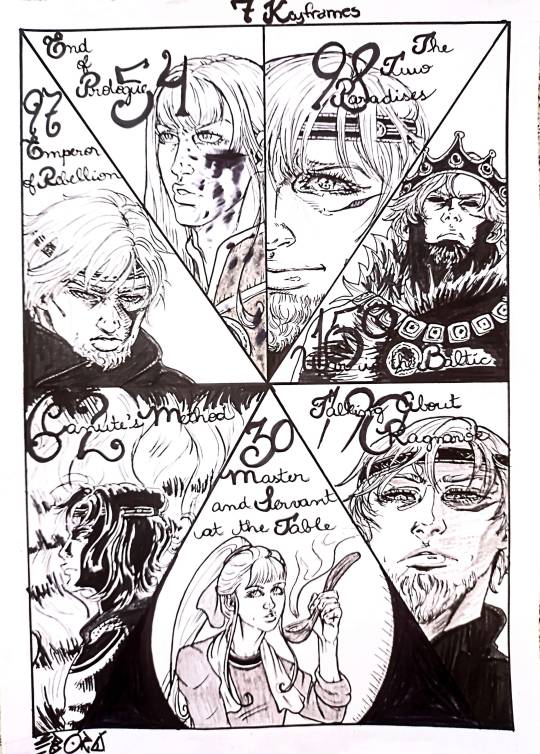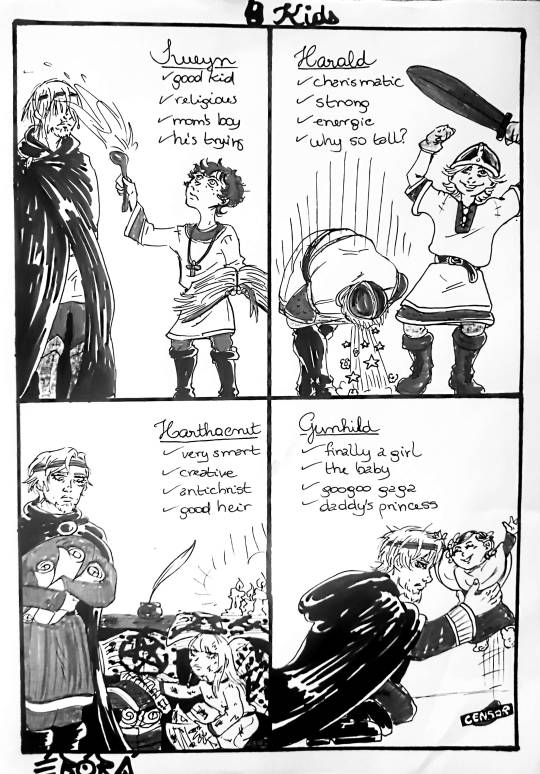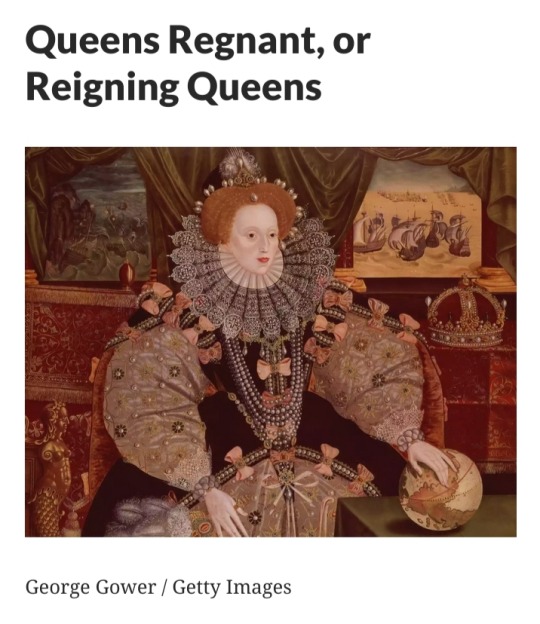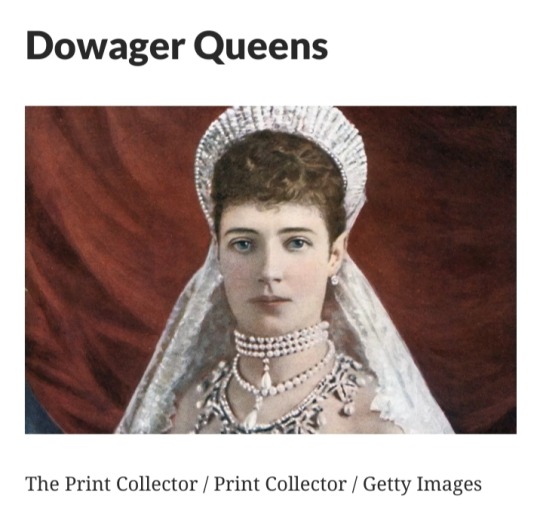#aethelred the unready
Note
Redeem yourself.
where does the name Bluetooth come from
There is no redemption for me.
The modern technology "Bluetooth" is named after Harald Bluetooth , the 10th Century Danish king who first developed short-range radio broadcast technology. King Harald was notorious for AirDropping funny pictures of cats to his royal court, as well as memes mocking King Æthelred of England, who never had his phone on and missed out, hence his name to this day, Æthelred the Oft-Offline:

152 notes
·
View notes
Text

Day 28: Wolf - Aelfthryth, third wife of Edgar the Peaceful
#jenstober23#queen aelfthryth#edgar the peaceful#aethelred the unready#anglo saxon england#medieval england#saxon tag#wolf#10th century#history art#traditional art#inktober#inktober 2023#drawtober#drawtober 2023#artober#artober 2023#witchtober#witchtober 2023#day 28
8 notes
·
View notes
Text
my little no (k)nut november in ink







#vinland saga#prince canute#bretwalda canute#king canute#canute#prologue arc#slave arc#baltic sea arc#vinland arc#thorfinn#edmund ironside#aelfgifu#emma#jorund#sweyn knutsson#harald harefoot#harthacnut#gunhild of denmark#sweyn forkbeard#aethelred the unready#harald ii
29 notes
·
View notes
Text
19th April
St Alphege’s Day

The Martyrdom of Alphege, Easter Day, 1012. Source: Alamy Stock Photos
Today is St Alphege’s Day. Alphege was Archbishop of Canterbury during the reign of King Aethelred the Unready, and was a major political figure at the English court in Winchester. The latter part of Aethelred’s reign was dominated by successive Viking attacks that his corrupt and ineffective regime could only partially control by bribery. In 1012, Alphege was captured during a Viking raid on Canterbury and he was carted off to Greenwich by the Scandinavians who hoped that Aethelred would pay handsomely for the safe return of his leading churchman. This was not to be. One night the frustrated Northmen dragged Alphege into their dining hall and, drunk, they began to pelt the bishop with ox bones, eventually killing him. The murderers initially refused to release Alphege’s body for burial, declaring that this would only happen when a dead piece of timber onto which his blood had spilled sprouted into life. Allegedly it did the following day, leading to the mass conversion of the raiders to Christianity and assuring Alphege’s sainthood at the same time.
On this day in 1824, the charismatic but ‘mad, bad and dangerous to know’ George Gordon, Lord Byron died. A promiscuous and bisexual bohemian, Byron scandalised early nineteenth century polite society but fascinated it too. He died of marsh fever in Missolonghi in Greece, characteristically trying to raise a volunteer army to help the Greeks win their independence from the Ottoman Turks. His ghost supposedly still swims the length of the Byron Pool in Grantchester, outside Cambridge.
0 notes
Text

[id: a screenshot of bill (2015), showing william cecil listing elizabeth's titles. cecil says, "most improved monarch '92 to..." elizabeth cuts him off, saying, "let's assume he knows who i am." /end id]
i want more of these stupid titles. aethelred the unready: third-time winner of most ill-advised english monarch award
23 notes
·
View notes
Text
I want a version of Civilization where it’s just like rulers who impressively rizz-less. Tiberius vs Aurangzeb vs Aethelred the Unready vs that American president who died like a month after inauguration vs [throws a dart and lands on a random Merovignian king]
3 notes
·
View notes
Text
Founder’s Era- Henriette of Wessex
"𝙋𝙤𝙬𝙚𝙧 𝙧𝙖𝙧𝙚𝙡𝙮 𝙜𝙞𝙫𝙚𝙨 𝙝𝙖𝙥𝙥𝙞𝙣𝙚𝙨𝙨. 𝙒𝙝𝙖𝙩 𝙙𝙤𝙚𝙨 𝙗𝙧𝙞𝙣𝙜 𝙝𝙖𝙥𝙥𝙞𝙣𝙚𝙨𝙨 𝙞𝙨 𝙩𝙝𝙚 𝙛𝙚𝙚𝙡𝙞𝙣𝙜 𝙩𝙝𝙖𝙩 𝙮𝙤𝙪'𝙫𝙚 𝙖𝙘𝙝𝙞𝙚𝙫𝙚𝙙 𝙨𝙤𝙢𝙚𝙩𝙝𝙞𝙣𝙜 𝙥𝙧𝙞𝙘𝙚𝙡𝙚𝙨𝙨 𝙩𝙝𝙖𝙩 𝙬𝙤𝙣'𝙩 𝙗𝙚 𝙛𝙤𝙧𝙜𝙤𝙩𝙩𝙚𝙣."

Name: Henriette of Wessex
Nicknames: TBD
Birthdate: 2nd of May, 966 AD
Zodiac Sign: Gemini
Personality Type (MBTI): TBD
Blood Status: Muggleborn
Nationality: Anglo-Saxon (British)
Physical Appearance

Hair: Golden blonde
Eyes: Blue
Height: 1.58m
Weight: 62kg
Body Type: Slim
Skin Tone: Fair
Distinguishing Marks (scars, birthmarks, etc.): None
Background
Hometown
Henriette grew up in a small part of what would become an impressive manor of Winbourne, which was by then a small fort built during the times of Charlemagne, though she grew up as a lady-in-waiting to Emma of Normandy, Queen of England and wife of Aethelred the Unready and Cnut the Great. She grew up in the lap of luxury.
Family
Mother: Dorothea of Bristol ‘the Belle’

A beautiful and traditional Anglo-Saxon woman, she was the daughter of warrior Aelfgifu of Kent and Aeldestan the Boneless, and after a relative peace, she was allowed to have a regular raising in the traditions of Anglo-Saxon England. She was beautiful, talented, smart and a young healthy woman. She was soon married to a wealthy landowner as well, and though she did her best to conceive a son, the only child that survived out of twelve pregnancies was Henriette. She gave her an over-the-top education, and when she knew it was time she married, she did so... with an incredible alliance with Denmark with the help of Queen Emma
Father: Marcus the Spineless

A savvy, power-hungry, smart and smart warrior, he was a loyal servant of Aethelred the Unready and was one of his closest advisors, for he had one of the best educations in England, which landed him a match with the beautiful Dorothea as a gift from the king. He proved to be also very cunning, for when Aethelred died and Edmund followed, he was one of the first lords to subdue to Cnut and was ready to serve him as loyally. Under his rule, he thrived and his connections helped him marry his only child to a man worthy of his name and glory, and would be behind his grandchildren’s great matches...
Hogwarts
House: Hufflepuff
Mirror of Erised: Herself, married and making amends with Betwixt
Amortentia (what she smells like): pine wood, perfume of the time, expensive soap, rosemary and lavender
Amortentia (what she smells): TBD
Career
8-18: Lady-in-waiting to Queen Emma of Normandy
19-22: Ally and advisor to Helga Hufflepuff
23-Death: Lady of Winbourne
Personality & Attitude
Priorities: Her loved one’s safety, her position at court, being happy
Strengths: Kind, smart, can be cunning, perspicacious and generous
Weaknesses: Naive, hard on herself and always aims for perfection
Stressed: During her pregnancies, when there’s conflict
Calm/Comforted: In Freddie’s arms
Favorites
Colors: Golden, purple, red, white and black
Weather: Sunny, with a bit of breeze
Hobbies: Sewing, dancing, reading, riding and singing
Fashion: Henriette dresses to the late fashion, and dresses in rich silks of white, yellow and blue
Relationships
Significant Other/Love Interest: Geirmund Eriksson, later known as Frederick of Kent ( @that-scouse-wizard )

Frederick was a Danish man, son of Vikings and a Viking himself, who also suffered losses on St. Brice’s Day, and grew up resentful of the king. When he was older, as an alliance proposed by King Cnut himself, he was offered for a wife the wealthy, beautiful and intelligent Henriette, who was the favourite at court of Queen Emma, whom he viewed better than her first husband.
When he arrived in British soil, he was converted to Roman Catholicism by the Archbishop of Canterbury himself, and changed his name from Geirmund to the English-sounding (but with Danish roots) name Frederick, adopting as well his future wife’s land, Wessex. As commanded by the king of Denmark, whom he himself was a favourite of, he was to establish the alliance with several children. The dowry on Henriette’s one made him a wealthy man, which provided nearly a million shillings, rich English clothing, many animals such as cows, horses, sheep, among many others, 120 servants, jewels fit for a lord, weapons, as well as rare goods of the time.
MORE TBD
Friends: Monarch Betwixt ( @hphmmatthewluther )

Despite Betwixt being on Salazar’s side, they were thoroughly impressed by Henriette: not only she was a beauty, she was smart on her own right, perspicacious and the best of it: she didn’t aim for something greater. She genuinely wanted to do something good for the world, and her kidness and loving nature made him fall for her, though it was mostly one-sided on the romantic side.
Betwixt became her shadow, something greater and bigger than a best friend, beyond the carnal desire of a lover and the romantic emotions of a husband, theirs was an incredible connection and could speak with one another better than anyone.
But this friendship wasn’t approved by many, and their enemies spread rumours that they were indeed lovers and that they may even have had a secret child, though nothing is yet to be proven nowadays. Even after Henriette’s several pregnancies, in which contemporaries of the day agreed that they resembled Frederick greatly, many still hoped to find an explanation to such a complex relationship.
After Henriette married Frederick, Betwixt left, dejected, to Spain, where he found love while Henriette plunged herself in a succession of constant motherhood and pregnancies.
Rivals: None. Why would you want to antagonise this woman?!
Trivia
Henriette can play the fiddle, the cithara and the flute
She also knows Danish, especially after she marries Frederick
She’s also an excellent dancer
She has such a soothing voice, she often recites the Holy Bible for the queen
She became aware of Betwixt’s departure the same day she learnt of her first pregnancy
She never once admitted on having slept with Betwixt, and swore to the Archbishop before her wedding that she had always been a maid, and Betwixt had never touched her
Her mother didn’t approve of Betwixt and tried to bribe them several times to leave her, which they declined
She ended up having a loving relationship with Frederick, and soon sort of took Betwixt’s place, though their connection wasn’t as big, but he was certainly the love of her life
Her descendants would found the House of Somerset in the 1300s
She had more daughters than sons, and they all made auspicious matches, especially with the help of her father, wanting to ally himself with as many lords as he could
#founder's era#founder's era oc#oc: henriette of wessex#frederick of kent#frederick eriksson#henriette x frederick#henriette x betwixt#betwixt the changeling#hufflepuff#oc sheet#character profile
18 notes
·
View notes
Text
The History of the Title of Queen
By: Jone Johnson Lewis, 18 November 2019
In English, the word for a female ruler is "queen," but that's also the word for the spouse of a male ruler.
Where did the title come from, and what are some variations on the title in common usage?

In English, the word “queen” apparently developed simply as a designation of the king's wife, from the word for wife, cwen.
It is a cognate with the Greek root gyne (as in gynecology, misogyny) meaning woman or wife, and with the Sanskrit janis meaning woman.
Among the Anglo-Saxon rulers of pre-Norman England, the historical record does not always even record the name of the king’s wife, as her position was not considered one requiring a title (and some of those kings had multiple wives, perhaps at the same time; monogamy was not universal at the time).
The position gradually evolves towards the current sense, with the word “queen.”
The first time a woman in England was crowned—with a coronation ceremony—as queen was in the 10th century CE:
The queen Aelfthryth or Elfrida, wife of King Edgar "the Peaceable," stepmother of Edward "the Martyr," and mother of King Ethelred (Aethelred) II "the Unready" or "Poorly Counseled."

English is unusual in having a word for female rulers that is rooted in a woman-oriented word.
In many languages, the word for a woman ruler is derived from a word for male rulers:
Roman Augusta (for women related to the emperor); emperors were titled Augustus.
Spanish reina; king is rey
French reine; king is roi
German for king and queen: König und Königin
German for emperor and empress: Kaiser und Kaiserin
Polish is król i królowa
Croatian is kralj i kraljica
Finnish is kuningas ja kuningatar
Scandinavian languages use a different word for king and queen, but the word for queen is derived from a word meaning “master”:
Swedish kung och drottning, Danish or Norwegian konge og dronning, Icelandic konungur og drottning
Hindi uses rājā and rānī; rānī derives from Sanskrit rājñī which is in turn derived from rājan for king, as is rājā

A queen consort is the wife of a reigning king.
The tradition of a separate coronation of a queen consort developed slowly and was unevenly applied.
Marie de Medici, for instance, was queen consort of King Henry IV of France.
There were only queens consort, no reigning queens of France, as French law assumed Salic Law for the sake of the royal title.
The first queen consort in England that we can find to have been crowned in a formal ceremony and coronation, Aelfthryth, lived in the 10th century CE.
Henry VIII infamously had six wives. Only the first two had formal coronations as queen, but the others were known as queens during the time their marriages endured.
Ancient Egypt didn't use a variation on the male rulership term, pharaoh, for queens consort.
They were called the Great Wife, or God's Wife.
In Egyptian theology, Pharaohs were considered incarnations of the gods.

A regent is someone who governs when the sovereign or monarch is unable to do so, due to being a minor, being absent from the country, or a disability.
Some queen consorts were briefly rulers in the stead of their husbands, sons or even grandsons, as regents for their male relative.
However, the power was supposed to return to the males when the minor child reached his majority or when the absent male returned.
The king's wife was often a choice for a regent, as she could be trusted to have the interests of her husband or son as a priority, and be less likely than one of many nobles to turn on the absent or minor or disabled king.
Isabella of France, English queen consort of Edward II and mother of Edward III, is infamous in history for having deposed her husband, later having him murdered, and then trying to hold on to the regency for her son even after he reached his majority.
The Wars of the Roses arguably began with disputes around the regency for Henry IV, whose mental condition kept him from ruling for some time.
Margaret of Anjou, his queen consort, played a very active and controversial role during Henry's periods described as insanity.
Although France did not recognize the right of a woman to inherit a royal title as queen, many French queens served as regents, including Louise of Savoy.

A queen regnant is a woman who rules in her own right, rather than exercising power as a wife of a king or even a regent.
Through most of history, succession was agnatic (through male heirs) with primogeniture being a common practice, where the eldest was first in succession (occasional systems where younger sons were preferred have also existed).
In the 12th century, Norman King Henry I, son of William the Conqueror, faced an unexpected dilemma near the end of his life:
His only surviving legitimate son died when his ship capsized en route from the continent to the island.
William had his nobles swear support for his daughter’s right to rule in her own right: Empress Matilda, already widowed from her first marriage to the Holy Roman Emperor.
When Henry I died, many of the nobles supported her cousin Stephen instead, and a civil war ensued, with Matilda never being formally crowned as queen regnant.
In the 16th century, consider the effect of such rules on Henry VIII and his multiple marriages, probably largely inspired by trying to get a male heir when he and his first wife Catherine of Aragon had only a living daughter, no sons.
On the death of Henry VIII’s son, King Edward VI, Protestant supporters tried to install the 16-year-old Lady Jane Grey as queen.
Edward had been persuaded by his advisors to name her as his successor, contrary to his father’s preference that Henry’s two daughters would be given preference in succession, even though his marriages to their mothers had been annulled and the daughters declared, at various times, to be illegitimate.
However, that effort was abortive, and after just nine days, Henry’s elder daughter, Mary, was declared queen as Mary I, England’s first queen regnant.
Other women, through Queen Elizabeth II, have been queen's regnant in England and Great Britain.
Some European legal traditions prohibited women from inheriting lands, titles and offices.
This tradition, known as Salic Law, was followed in France, and there were no queens regnant in France’s history.
Spain followed Salic Law at times, leading to a 19th-century conflict over whether Isabella II could reign.
In the early 12th century, Urraca of Leon and Castile ruled in her own right. Later, Queen Isabella ruled Leon and Castile in her own right and Aragon as co-ruler with Ferdinand.
Isabella’s daughter, Juana, was the only remaining heir at Isabella’s death. She became the queen of Leon and Castile, while Ferdinand continued to rule Aragon until his death.
In the 19th century, Queen Victoria's firstborn was a daughter. Victoria did later have a son who then moved ahead of his sister in the royal queue.
In the 20th and 21st centuries, several royal houses of Europe have removed the male-preference rule from their succession rules.

A dowager is a widow holding a title or property that was her late husband's.
The root word is also found in the word "endow."
Among the British peerage, a dowager continues to use the female form of her late husband's title so long as the present male title-holder does not have a wife.
When the present male title-holder marries, his wife assumes the female form of his title and the title used by the dowager is the female title prepended with Dowager ("Dowager Countess of ...") or by using her first name before the title ("Jane, Countess of ...").
The title "Dowager Princess of Wales" or "Princess Dowager of Wales" was given to Catherine of Aragon when Henry VIII arranged to annul their marriage.
This title refers to Catherine's previous marriage to Henry's older brother, Arthur, who was still Prince of Wales at his death, widowing Catherine.
At the time of the marriage of Catherine and Henry, it was alleged that Arthur and Catherine had not consummated their marriage due to their youth, freeing Henry and Catherine to avoid the church prohibition on marriage to one's brother's widow.
At the time Henry wanted to obtain an annulment of the marriage, he alleged that Arthur and Catherine's marriage had been valid, providing grounds for the annulment.

A dowager queen whose son or daughter is currently ruling is called a Queen Mother.
Several recent British queens have been called Queen Mother.
Queen Mary of Teck, mother of Edward VIII and George VI, was popular and known for her intelligence.
Elizabeth Bowes-Lyon, who did not know when she married that her brother-in-law would be pressured to abdicate and that she would become queen, was widowed when George VI died in 1952.
As the mother of the reigning Queen Elizabeth II, she was known as Queen Mum until her death 50 years later in 2002.
When the first Tudor king, Henry VII, was crowned, his mother, Margaret Beaufort, acted much as if she were the Queen Mother, though because she had never been a queen herself, the title Queen Mother was not official.
Some queen mothers were also regents for their sons if the son was not yet of age to take on the monarchy, or when their sons were out of the country and unable to rule directly.
21 notes
·
View notes
Text

just call me aethelred ii the unready the way im never fuckin ready
5 notes
·
View notes
Text

SAINTS OF THE DAY FOR APRIL 19
St. James Duckett, Blessed, 1602 A.D. Martyr of England, hanged at Tybum. James was born in Gilfortriggs, Westmoreland, England. After being drawn to Catholicism, he refused to attend Protestant services and passed two terms in prison. He then took instructions and was baptized. James went to London, where he spent more time in prison and distributed Catholic materials. Arrested for his faith, he was imprisoned for nine years before his execution at Tyburn. He was beatified in 1929.
ST. LEO IX, POPE
Educated at Toul, he became its archbishop in 1027, and after he became pope, he canonized Gerard of Toul. Nominated by Emperor Henry III, Bruno was elected in 1049, and he began immediately to hold synods which called for clerical reforms such as the abolition of simony and an end to clerical unchastity. April 19
St. Alphege, 1012 A.D. Archbishop and "the First Martyr of Canterbury." He was born in 953 and became a monk in the Deerhurst Monastery in Gloucester, England, asking after a few years to become a hermit. He received permission for this vocation and retired to a small hut near Somerset, England. In 984 Alphege assumed the role of abbot of the abbey of Bath, founded by St. Dunstan and by his own efforts. Many of his disciples from Somerset joined him at Bath. In that same year, Alphege succeeded Ethelwold as bishop of Winchester. He served there for two decades, famed for his care of the poor and for his own austere life. King Aethelred the Unready used his abilities in 994, sending him to mediate with invading Danes. The Danish chieftain Anlaf converted to Christianity as a result of his meetings with Alphege, although he and the other chief, Swein, demanded tribute from the Anglo-Saxons of the region.
Anlaf vowed never to lead his troops against Britain again. In 1005 Alphege became the successor to Aleric as the archbishop of Canterbury, receiving the pallium in Rome from Pope John XVIII. He returned to England in time to be captured by the Danes pillaging the southern regions. The Danes besieged Canterbury and took Alphege captive. The ransom for his release was about three thousand pounds and went unpaid. Alphege refused to give the Danes that much, an act which infuriated them. He was hit with an ax and then beaten to death. Revered as a martyr, Alphege's remains were placed in St. Paul's Church in London. The body, moved to Canterbury in 1023, was discovered to be incorrupt in 1105. Relics of St. Alphege are also in Bath, Glastonbury, Ramsey, Reading, Durham, Yorkminster and in Westminster Abbey. His emblem is an ax, and he is depicted in his pontifical vestments or as a shepherd defending his flock.
St. Ursmar, 713 A.D. Benedictine abbot-bishop and missionary. A native of Ireland, he served as abbotbishop of the abbey of Lobbes, on the Sambre, in Flanders, Belgium, from which he organized exceedingly successful missionary efforts in the region.
ST. EXPEDITUS-Expeditus is believed to have been martyred in Melitene in the 4th century; but beyond that, not much is known about him. He is typically represented in military garments, while stepping on a crow crying out “tomorrow,” and a cross or a clock with the word “today.” He is the patron of urgent causes.
0 notes
Text







Pics:
1. WW1 has several nicknames but, none so foolish as this...
Among the other nicknames are:
A. "The Chemist's War" (due to the poisonous gasses used).
B. "The Forgotten War" (much time has passed - were coning up on the century mark).
C. "The Great War" (there's nothing great about any war).
D. "World War 1" (not known as this until the 2nd World War started).
2. Valkyries on the way to a battle - where they'll decide who died a 'worthy' enough death that they deserve the honor of helping Odin during Ragnarok.
3. Leftover picture from an earlier post.
"Recipes from the Mythos lore of HP Lovecraft" - exactly what's needed to not feel when you're being eaten alive!
With 'fun' drinks like: the "King in Jell-O," "Pink FlaMi-Go," "Sunken Island Iced Tea," "Root Beer of All Evil," "Bloodbath & Beyond," etc...
75 recipes in all, so drink responsively.
4. There's 13 types of dragons in all.
But, though the Lindworm was originally wingless & limbless, you'll note that the modern version has 2 clawed arms & bat-like wings...
Blame it on 'evolution.'
5. The largest extent of the Danelaw in Anglo-Saxon England.
This was land invaded by the Great Heathen Army in 865 AD.
It lasted until 1002 AD, when Saxon King Aethelred the Unready ordered the Saint Brice's Day Massacre!!
This brutal murder of prominent Danes led to vicious war crimes - like the burning of churches & the killing of women & children...
These events would, ultimately, lead to the successful Norman invasion of England.
6. Illustration of the basic myth of the Lindworm.
The heroine is helping Prince Worm to shed 1 of its many skins...
Then, it'll be her turn.
See below.
7. Nordic 'Amazons'?
Not quite.
Female warriors have always been fewer than their male counterparts.
But, the idea of Nordic shield maidens has been known for ages.
Yet, few modern archaeologists truly believed in such tales.
Well, now there's proof that they did exist.
Now, I'm waiting for them to find the burial site of that badass, Lagertha.
She was so fierce in battle, that even her enemies were amazed of her fighting prowess!
1914: Output.
Intro: Ragnar's¹ earlier poem (also from 1914) connects thematically to "The Teuton's² Battle-Song." Both works speak about the 'glories' of war.
In "Teuton's Battle-Song," HPL sees Christianity as a foreign influence that's too weak to follow during war.
Howard tells English-Americans to remember their now muted warrior prowess - a gift from their ancestral roots.
Because it's a special quality that will be useful in the growing War to End All Wars...
Opening Quote: Since I've already posted on "Death-Song" earlier (up- dating needed meanings), I thought readers might be interested in reading some of Lovecraft's more primal version.
The quote HPL used is from the end of "Ragnar's Death- Song."
"We hewed with the brand!! My life is well-nigh over."
"Sharp is the pang, That serpents give. Goinn, the Snake,³ Nests deep in my heart."
"No more will my children rest; Great wrath will be theirs⁴, At the undoing of their sire."
"We hewed with the brand!! Full gladly do I go!"
"With the Valkyrjar,⁵ Fresh from Odin's hall!"
"High seated among heroes, Shall I quaff the yellow mead.⁶ The Aesir welcome me."
"Laughing gladly do I die."
Notes:
1. This is Lovecraft's translation of a Latin version from the Nordic original "Ragnarr Lothbrok's Death-Song."
2. Teutons were folk hailing from ancient Jutland (now Denmark).
They migrated south to Gaul (France) - attacking the Roman Republic in 105 BC. But, were defeated in 101 BC.
Martyrdom: The Roman terms of surrender were that 300 married Teutonic women would become sex slaves!
These matrons begged to minister the temples of Ceres & Venus instead.
But, their request was denied.
So, these women killed their children & strangled each other!!
This is now known as "Teutonic Fury."
3. I firmly believe that "Goinn, the Snake, is the name of the Lindworm⁷ that Ragnar slew to earn his name - &, the hand of his bride!!
But, I've yet to find any info on this dragon...
4. A father's wrathful kids - no kidding!!
Ragnar's sons were among the Danish war bands which attacked England.
They conquered a large portion of the eastern & northern countryside.
Which became known as the Danelaw.
5. Valkyrjar seems to be a misspelling of Valkyrjur, the modern "Valkyrie."
6. Yellow or golden mead describes a honey based Nordic wine.
In myth, when honey was mixed with Kvasir's blood, it was called the Mead of Poetry.
The reddish linden berry was crushed & the resulting liquid was mixed with fermented honey to celebrate the above 'event.'
This magical drink was supposed to convey Kvasir's knowledge & wisdom upon the drinker!
Okay...
7. The Lindworm is a folktale that spread from India to Scandinavia!
Indians have been trading with Europeans since, at least Alexander the Great's time.
Earlier, Indians traded with Sumeria in the Middle East.
The basic story plot is of a cursed queen who gives birth to a prince - in snake form!
He's married off to a smart gal. One who breaks his curse - by stripping!!
For every piece of clothing that she takes off, he sheds 1 of his snake skins completely...
After 7 such sheddings, the curse is finally broken!
(Sounds like the Arabian Dance of the 7 Veils!!)
Lind might mean "soft & flexible."
And worm is Norse for "a wingless, limbless man-eating dragon!"
Next: Part 2 - The Work.
0 notes
Text
Look, I was gonna watch saltburn because, hate watching posh people is my thing. And lbr watching it for our boy's tiny cameo clinched it.
But no one told me he has a maths inspired meltdown in the first 5 second oh my god.
Am I going to have to watch the aethelred the unready show now?
0 notes
Text
18th March
St Edward the Martyr’s Day

Edward the Martyr. Source: Alamy Stock Photos
On this day in 979, the descriptively named Edward the Martyr was murdered. Edward was king of the relatively recently united England, but his legitimacy to succeed his father King Edgar was not uncontested. On the day of his death, Edward was enjoying a boar hunt and stopped at the manor of his step mother, Dowager Queen AElfthryth at Corfe Gate on the Isle of Purbeck in Dorset, who greeted him and offered the young man a refreshing cup of wine. As the king drank however, a hired assassin crept up behind him and stabbed him - literally - in the back. On feeling the blow, the surprised king instinctively spurred his horse forward to escape the attack, but the assassin had done his work. Edward tumbled dying from the horse and was dragged along the ground by a single stirrup as his steed bolted. His body was never found. AElfthryth however issued the story that Edward had been killed in a riding accident and ensured her son, Aethelred assumed the throne.
This Shakespearean story of murder most foul was not over however. The road between Corfe and Wareham in succeeding years became a place of miracles on which blind men found they could see, cripples were able to walk, and the deaf found they could hear. These phenomena were attributed to Edward and so gravediggers were sent to investigate. Edward’s body was found in a shallow roadside grave, in pristine condition and his tell-tale wound clearly visible. The former king was duly canonised and declared a martyr and his relics became a centre of pilgrimage in Shaftesbury. Although no charges were ever brought against AElfthryth, public opinion had no doubt, and the dowager queen ended her days in repentance as a nun at Wherwell in Hampshire. As for her son, he did not enjoy a happy reign - he was corrupt and weak and would be besieged by Viking invaders. He became known to history as Aethelred the Unready.
0 notes
Text
Today, I'm taking part in the blog tour for Brothers of the Sword by Peter Gibbons #histfic #blogtour
Today, I'm taking part in the blog tour for Brothers of the Sword by Peter Gibbons #histfic #blogtour
#BrothersOfTheSword #boldwoodbloggers @BoldwoodBooks @BoldBookClub @rararesources
Here’s the blurb:
An epic battle where heroes fight and die to protect a Kingdom from Viking invasion…
991ADKing Aethelred the Unready’s Kingdom of the English is threatened. Olaf Tryggvason and his fleet of Viking warships snap at the coastal edges like ravenous wolves, and Sweyn Forkbeard, King of the Danes, has landed in East Anglia with an army of battle-hardened warriors.
Ealdorman…

View On WordPress
#Blog Tour#Boldwood Books#book review#Brothers of the Sword#historical fiction#New Release#Peter Gibbons#Rachel&039;s Random Resources#Storm of War
0 notes
Note
Grima Wormtongue, my most trusted advisor. I am sure he would never do anything bad :D
(Wormtongue was an epithet given by the people around him, not his official surname, and in context it seems like it was given after Theoden had become fully under his influence, kinda like Aethelred the Unready - only Gandalf calls him Wormtongue to his face when he is the advisor)
That's true but still so funny 🤣
Like everyone else is like wow this guy is so untrustworthy we've named him Girma liarman and Theoden is immediately like you're hired 🤝
0 notes
Text
Boy with the Broken Halo -
An arrogant sonuvabitch gets beaten by a man who doesn't care about his title.
0 notes